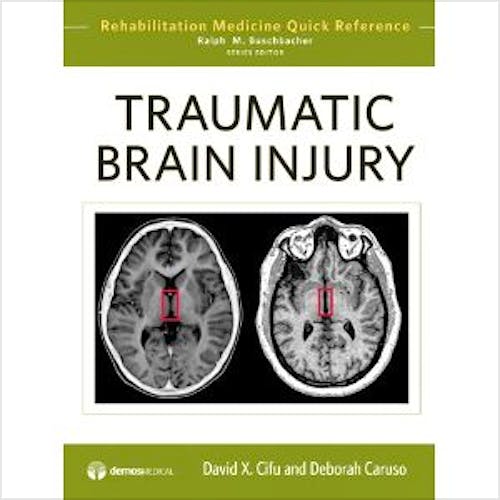

No hay productos en el carrito



Traumatic Brain Injury (Rehabilitation Medicine Quick Reference)
Cifu, D. — Caruso, D.
1ª Edición Marzo 2010
Inglés
Tapa dura
240 pags
1000 gr
22 x 29 x 2 cm
ISBN 9781933864617
Editorial Springer Publishing Co
LIBRO IMPRESO
-5%
165,85 €157,56 €IVA incluido
159,47 €151,50 €IVA no incluido
Recíbelo en un plazo de
2 - 3 semanas
Description
About the RMQR Series:Designed for the busy practitioner seeking quick answers when diagnosing and treating common—and not so common— disorders. Each volume in the series focuses on a key area of rehabilitation medicine and breaks down the problems, treatments, and expected results into succinct facts, organized alphabetically and presented in bullet-point style for quick reference in the office or clinic. Whether the practitioner needs to look up a diagnostic question, neurorehabilitation complication, or sports intervention, this series provides the answers.
Practitioners today see increasing numbers of brain injuries across the country and around the globe. The causes run the gamut of human endeavor, from frailty associated with aging, military activity, sports, and motor vehicle accidents of all kinds. With a growing awareness of the effects of traumatic brain injury (TBI) and the need for early intervention to ameliorate these effects and improve patient outcomes have come demand for practical information for clinicians on the “frontlines”
Traumatic Brain Injury: Rehabilitation Medicine Quick Reference provides the necessary knowledge the busy practitioner needs to deliver quality care to TBI patients. Addressing one hundred varied topics presented in a consistent two-page format for maximum clinical utility, this nuts and bolts resource is organized in three sections. The first focuses on assessment of acute or chronic TBI, covering physical examination and diagnostic testing. The bulk of the book provides an alphabetically arranged catalog of brain injury conditions and sequelae commonly seen by practitioners, as well as specialized areas of TBI care for unique patient populations such as sports or military injury, and sequelae, such as post-traumatic stress disorder or neuroendocrine disorders. The final section outlines treatment interventions and expected functional outcomes.
Features of Rehabilitation Medicine Quick Reference series titles include:
- Comprehensive coverage of all important topics in PM&R
- Multi-specialty editorship and authorship
- Chapters are organized into succinct facts, presented in a bullet point format
- Laid out for easy look up by syndrome, complication and treatment
- Focus on clinical management provides readers with hands-on, practical guidance for all types of interventions and therapies
- Consistent approach allows readers to know exactly where to find the information they need rapidly
- “Pitfalls”, “Red Flags”, “Complications”, and “Helpful Hints” help guard against unwanted sequelae
Contents
Traumatic Brain Injury Basics: 1.Traumatic Brain Injury History; 2. Physical Examination; 3. Assessment Scales: Agitation; 4. Assessment Scales: Balance and Dizziness; 5. Assessment Scales: Cognition; 6. Assessment Scales: Concussion Grading; 7. Assessment Scales: Injury Severity Measures; 8. Assessment Scales: Level of Arousal, Attention and Cognition; 9. Assessment Scales: Orientation; 10. Assessment Scales: Post-concussive Symptom; 11. Assessment Scales: Sleep; 12. Assessment Scales: Smell; 13. Diagnostic Tests: Balance and Dizziness; 14. Diagnostic Tests: Bowel and Bladder Function; 15. Diagnostic Tests: Electrophysiologic Evoked Potentials; 16. Diagnostic Tests: Neuroimaging Findings in TBI; 17. Diagnostic Tests: Neuroimaging Techniques; 18. Diagnostic Tests: Swallowing; 19. Diagnostic Tests: Vascular; Conditions: 20. Agitation/Restless Behavior; 21. Akinetic Mutism; 22. Aphasia, Expressive (Motor); 23. Aphasia, Receptive (Sensory); 24. Attentional Deficits, Mild TBI; 25. Balance Deficits; 26. Bladder Issues; 27. Bowel Issues; 28. Central Dysautonomia; 29. Cognitive Deficits of TBI; 30. Combat-Related TBI; 31. Concussion, Cumulative Mild TBI; 32. Concussion, Mild TBI; 33. Concussion, Post-Concussive Symptoms/Syndrome (PCS)34. Concussion, Second Impact Syndrome; 35. Concussion, Sports; 36. Coordination Deficits; 37. Cranial Nerve Deficits – I (Anosmia); 38. Cranial Nerve Deficits – V, VII (Face); 39. Cranial Nerve Deficits – X, XI, XII (Head and Neck); 40. Cranial Nerve Deficits – III, I V, VI (Ocular movements); 41. Cranial Nerve Deficits – II, VIII, IX (Special Senses); 42. Cranial/Skull Defects (Craniotomy/Craniectomy/Cranioplasty); 43. Deep Venous Thrombosis (DVT); 44. Dementia and TBI; 45. Depression; 46. Disinhibition; 47. Dizziness; 48. Dysarthria; 49. Dysphagia; 50. Emotional Lability; 51. Executive Function Impairment; 52. Gait (Ambulation) Dysfunction; 53. Geriatric TBI; 54. Hearing Deficits; 55. Hemiparesis/Hemiplegia; 56. Heterotopic Ossification (HO); 57. Hyperesthesia; 58. Hypoarousal; 59. Hypoesthesia/Numbness; 60. Hypotonia/Flaccidity; 61. Insomnia; 62. Locked-In Syndrome (LIS); 63. Minimally Conscious State (MCS); 64. Neglect (Unilateral Spatial Inattention); 65. Neuroendocrine Dysfunction: Other; 66. Neuroendocrine Dysfunction: Syndrome of Inappropriate Antidiuretic Hormone (SIADH); 67. Neurolinguistic Deficits of TBI; 68. Pain: Complex Regional Pain Syndrome; 69. Pain, General; 70. Pain: Headaches; 71. Pediatric TBI; 72. Penetrating Injuries; 73. Posttraumatic Amnesia; 74. Posttraumatic Hydrocephalus; 75. Posttraumatic Seizures (PTS); 76. Posttraumatic Stress Disorder; 77. Pressure Sores; 78. Quadriparesis; 79. SCI and TBI: Dual Disability; 80. Sexual Dysfunction; 81. Shaken Baby Syndrome; 82. Spasticity/Hypertonicity/Rigidity/Clonus; 83. Tinnitus; 84.Tremors; 85. Vegetative State – Persistent (PVS); 86. Vision Deficits; 87. Visual Perceptual Deficits; Interventions: 88. Acute Management of Mild TBI; 89. Acute Management of Moderate-Severe TBI; 90. Agitation, Medications to Treat; 91. Complementary-Alternative Medicine; 92. Computer-based Cognitive Therapy; 93. Constraint-Induced Therapy; 94. Depression, Medication to Treat; 95. Disability Determination; 96. Intensity and Type of Therapy; 97. Outcome Assessment and Prediction; 98. Return to Sports; 99. Return to Work; 100. Spasticity, Oral Medications to Treat
About the Authors
- David X. Cifu, MD
David X. Cifu is Chairman and Herman J. Flax, MD Professor, Department of Physical Medicine and Rehabilitation, Virginia Commonwealth University - Deborah Caruso, MD
Deborah Caruso is clinical instructor, Department of Physical Medicine and Rehabilitation, Virginia Commonwealth University - Ralph Buschbacher, MD
Ralph Buschbacher is Professor of Clinical Physical Medicine / Rehabilitation, Indiana University
© 2025 Axón Librería S.L.
2.149.0